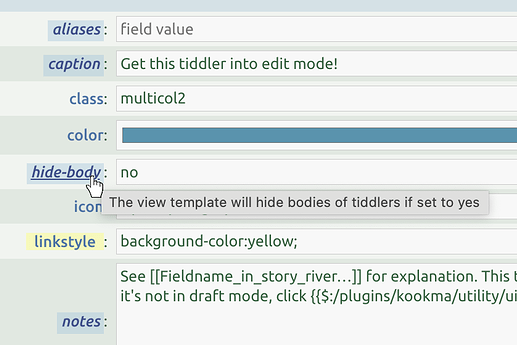Great conversation!
Do you mean a new cascade for how fields themselves display, either in edit mode or when transcluded as fields? Or do you mean a new cascade for how the story river shows the body of a tiddler [or node] when that tiddler is a fieldname (or specially-prefixed fieldname)?
It seems the second of these isn’t really necessary — the cascade for how the body of a tiddler (/node) is handled (plus view templates themselves, which can be conditional) already give us all the necessary tools.
But I’m intrigued by the idea of fields themselves being displayed and edited through cascade conditions. We already have a few different ways that fields display in edit mode (type is a drop-down, color is a color picker, tags have their proprietary edit interface; created/creator/modified/modifier are suppressed altogether in edit mode… and lots of us have been using longer textarea input boxes, invoked by some condition). Having a cascade for all this would open up room for people to develop various additional interfaces for editing and displaying (or hiding) fields (date/time pickers with certain conditional defaults, drop-downs based on a list condition articulated in the fieldname tiddler, etc.)
With your comment about new cascade for tag (tiddler?) templates, I again am not sure we need anything additional for how the tiddler displays (given the standard cascade for how body of tiddler/node is handled, plus conditional view templates)… But how tags themselves (tag-pills) display might benefit from a cascade… In off-the-shelf TW, the only variable is whether the tag has an assigned color, right? (I’ve also implemented italics text on tags that have no tagname home tiddler, and I often use ben webber’s tag-count solution.) Adding a cascade there might allow people to have tags whose style “pops” in response to certain conditions (tasks not done under this tag), or tagpills styled according to some variable (color-gradient that tracks quantity of tiddlers under that tag, etc.)
While we’re at it, being able to control the order of tags as displayed might be responsive to cascade conditions, just the way the order of items under a tag responds to a hierarchical array of criteria.
For the “missing” I’m not yet seeing why/how we would need a new cascade… Say more about what you have in mind, @TW_Tones?
It seems to me that we already have full control over how nodes display in the story river. In particular the $:/tags/ViewTemplateBodyFilter cascade can notice that a node !has[title] (to use @etardiff’s nice compact filter condition). Subconditions for different flavors of so-called “missing” tiddlers overlap in various ways with other aspects of that central cascade, so a separate cascade might be confusing. (With just one cascade, I can decide whether to catch prefix[$:/] before or after !has[title] etc. … If there were multiple cascades — with a separate one for the “missing” nodes — it seems we’d risk redundancy or lack of flexibility, no?)
 (so now I need to “touch” a bunch of tiddlers that I’ve updated during the lapse). Maybe I even tweak creator and created, if I actually made new tiddlers while timestamps were off). Or, I simply forgot to turn timestamps off before certain minor edits, and now want to back-date those tiddlers (to push them away from the top of the recent tiddlers list).
(so now I need to “touch” a bunch of tiddlers that I’ve updated during the lapse). Maybe I even tweak creator and created, if I actually made new tiddlers while timestamps were off). Or, I simply forgot to turn timestamps off before certain minor edits, and now want to back-date those tiddlers (to push them away from the top of the recent tiddlers list).
